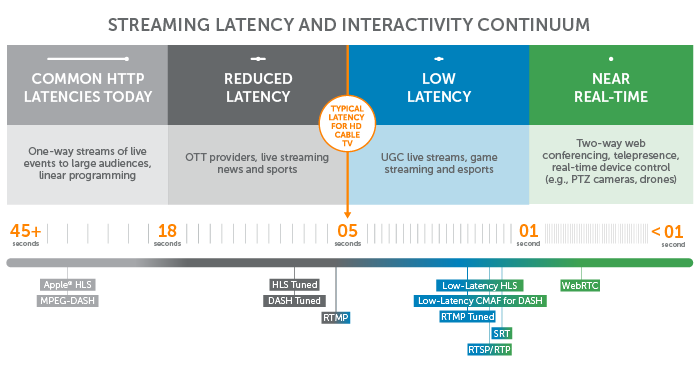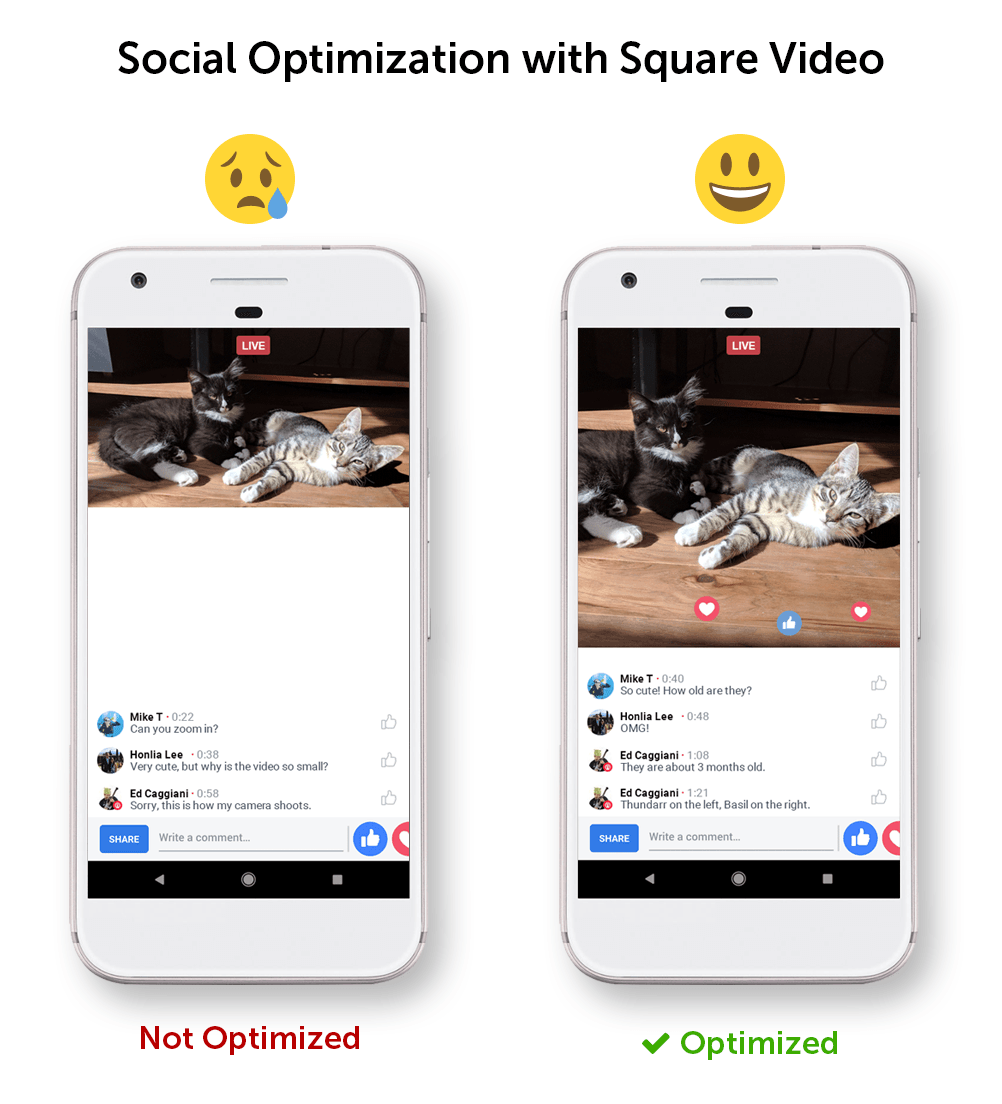2019 Streaming Trends

Update January 2020: We’ve published a more recent list of streaming trends, 10 Streaming Trends for 2020. Check out the post to learn about the most cutting-edge developments in the streaming industry.
Digital advancement is an evolution, not a revolution. As such, our list of 2019 streaming trends builds off of many you’ve seen before.
While it’s been around for some time, live streaming is taking off in 2019. With adoption rates exploding, use cases proliferating, and video quality continuing to increase, the streaming industry’s influence on everyday life is at its zenith.
Video is projected to account for 82 percent of internet traffic by 2022, a growing share of which will take the form of live streaming.*
The trifecta of technological advancement, improved connectivity, and video maturity makes streaming more accessible than ever. For this reason, video streaming will be employed not just by enterprises and media giants, but also by boutique organizations looking to engage customers near and far. From alternative meditation practices in the Pacific Northwest to artisanal cheese shops in the Netherlands, live streaming is now ubiquitously tied to business strategy.
Marketing requires it. Customer engagement depends on it. And innovation starts with it. For these reasons, organizations must either incorporate live streaming into their 2019 business plan — or risk falling behind.
The choice is yours. To help you prepare for what’s next, here’s our list of streaming trends for 2019.
Top 10 Streaming Trends for 2019
1. OTT Adoption Grows as Viewers Ditch Cable
Each year, more and more viewers ditch traditional satellite and cable services. So what’s it going to really take for audiences to transition entirely to over-the-top (OTT) services like Netflix?
Analysts have long held sports broadcasts as the saving grace for traditional television, with football games making up eight of the ten leading single telecast TV programs in 2017. But streaming services such as Sling and Hulu now deliver these programs directly to viewers’ living rooms over an internet connection. What’s more, today’s sports fans consume content in a variety of ways supplementary to television broadcasts. These include highlight reels, training camp live streams, and game recaps.
A final consideration previously in favor of satellite and cable sports broadcasting is the inherent latency of HTTP adaptive streaming formats. We’ve all heard of (or experienced) the scenario where your neighbors loudly celebrate a game-winning touchdown while your broadcast lags 20 seconds behind.
While OTT content has been delivered with far more latency than legacy TV in the past, new alternatives such as the Wowza Streaming Cloud™, WebRTC, and SRT offer near-real-time delivery from screen to screen.
-
2. Mobile Defines the Future of Streaming
Mobile’s role in streaming is nothing new, but it will continue to dominate in 2019.
PCs are forecast to account for only 19 percent of internet traffic by 2022; whereas smartphones will account for a whopping 44 percent.*
For this reason, we anticipate that vertical and square video formats will all but eradicate the traditional landscape format on social media. Initially a more ergonomic way to record videos, the vertical format quickly began to outperform those shot in landscape years back. Soon after, the Instagram-style square video edged out the vertical format.
While landscape videos will still have a place in the world of broadcasting, vertical and square formats will also begin to pop up outside of social media.

It’s yet to be seen which format (vertical or square) will reign supreme in 2019. Many social media platforms have enhanced the way vertical formats are experienced in order to optimize user interactivity. Advancements in augmented and virtual reality could also impact this.
One conclusion, however, is undeniable: Mobile will dictate the future of video.
3. Social Media Continues to Dominate Live Streaming
Streaming to Facebook, Instagram, Periscope, and similar platforms lies at the heart of any social-first content marketing strategy. Video consumption on social media began as a rather passive experience, with one-way broadcasts and limited interactivity to blame. Today, Facebook Live supports two-way interactions with reduced latency — as well as video chats through Facebook Messenger.
Other social media platforms putting their stamp on streaming include HQ Trivia and Confetti, where players can compete in live game-show environments for prizes. But streaming has moved beyond just social applications. Building an engaged community requires authentic interaction at every touchpoint.
Because social media platforms have conditioned us to expect, nay, demand instantaneous interaction via live video, brands must go beyond just social media for their live video strategies in 2019.
4. Streaming: No Longer Just for Marketing and eCommerce
In 2019, streaming should become an integral part of your brand’s entire strategy.
Examples of successful companies doing just that abound. Drive-through banking, virtual doctor visits, and other forms of customer support now use live video streaming to better engage customers and extend the physical reach of their employees. While haggling with a billing representative over a video call may not entice you, the possibility of live streaming to a mechanic (and thereby troubleshooting any issues without having to take your car into a shop) probably does.
For many new companies, streaming is foundational to the very services they offer. These brands are pushing the limits of what’s possible for streaming technology in 2019.
Consider Mercari. The eCommerce app has built a mobile marketplace where users buy and sell products via live video streaming. Why? Because real-time interactivity, community participation, and the closest possible experience to “being there” all help create an auction-like atmosphere that engages customers. Not convinced? The proof is in the pudding: In less than four years, the app surpassed 100 million downloads globally.
We’re excited to see the ways brands will create products and services with streaming as their basis in 2019.
Examples of other organizations offering streaming as a core competency are discussed below (IoT and Video Surveillance, Growing Importance of Streaming in Music Industry).
5. Increased Live Streaming in Internal Business Collaboration

From executive communications and employee training to internal meetings and job interviews, live video streaming has become second nature in today’s professional settings. This trend isn’t just a result of technological capabilities. Rather, there’s a genuine need to improve collaboration between globally dispersed workers.
Work-from-home flexibility and bring-your-own-device (BYOD) trends have extended video calls beyond the corporate network to include remote workers on mobile devices. As video calls get easier and connectivity improves, the barriers to using video streaming for this use case no longer stand.
Wowza’s no stranger to this trend. In fact, 70 percent of enterprise video platforms power their live video with Wowza. In 2019, we expect to see internal live video streaming prevalent in all business environments, resulting in an increase in remote workers.
6. Growing Importance of Streaming in the Music Industry
Video killed the radio star in the late seventies, and then TRL was canceled in 2008. But in 2019, video music broadcasting is back.
According to the Recording Industry Association of America (RIAA), streaming now accounts for 75 percent of the music industry’s revenue.
We recently posted a case study about one of our customers, a mobile app called Flits. The live-streaming music app allows users to merge their video streams of concerts with audio streams coming from the venue’s mixing board. That way, anyone viewing the stream gets an authentic and intimate visual experience — with sound quality that rivals the in-person acoustics. The app allows both musicians and viewers to play an active role in music broadcasting.

In addition to user-generated content, subscription services like Spotify and customized radio services like Pandora generate much of this revenue. We predict that video streaming’s role in the music industry will continue to climb as today’s consumers demand immersive audio-visual experiences. Read our blog article, Streaming in the Music Industry, for more information on this subject.
7. IoT and Video Surveillance

IoT video streaming dominates the market. Healthcare professionals rely on low-latency video streams for endoscopic surgical procedures, whereas those in law enforcement use body cams to capture low-light videos in HD. Recently, though, IoT streaming has moved beyond these niche applications and into the consumer world.
If streaming hasn’t already found its way into your home, it likely will in 2019. The number of devices connected to the internet will be more than three times the global population by 2022.*
Examples of IoT and video surveillance include pet monitors, security systems, doorbell cameras, IP cameras, and more. There are no limits to what you can video stream. Take Nest’s word for it, “For everything you need, there’s a Nest Cam.”
The smart home will go mainstream in 2019, with automated 5G systems enabling house monitoring like never before.
8. Growing Importance of Streaming in the Gaming Industry
Cisco forecasts that internet gaming traffic will grow ninefold between 2017 and 2022.* The role of streaming in this uptick will go beyond live streaming video platforms like Twitch and Vrumble. Instead, users will have the ability to stream the gaming services themselves as an alternative to purchasing them.
9. Virtual Reality (VR) and Augmented Reality (AR)
It’s hard to imagine what shape VR and AR may take given they’re still such nascent technologies.
Facebook rolled out Virtual Reality Live Streaming in July of 2017, and then 3D-180 video in June of 2018. As engagement with these formats continues to increase, marketers will be the first to adapt. Adoption has yet been slow, however, because it requires the right camera and hardware.
The immersive era of virtual reality is 100 percent underway. And in 2019, developers and manufacturers will pave the way as they further hone this technology.
10. Artificial Intelligence (AI) and Machine Learning
The amount of streaming data in the world grows exponentially each day. More data means more targeted content; but without a way to catalog the streams in real time, targeting isn’t possible.
Enter machine learning and AI. These technologies will continue to improve automation and indexing.
One such example is ClipMine, a video indexing platform acquired by Twitch in 2017. The platform translates visual and audio information from the streams into metadata that users can then filter. Rather than being done manually (as with adding titles, tags, and descriptions to a blog post), this learning-based video indexing platform analyzes live video content automatically. In 2019, we’re likely to see more sophisticated forms of real-time stream indexing.
Beyond that, real-time audio recognition will be used to prevent copyright infringement. Many developers have their sights set on doing so with the help of machine learning — something that titans of user-generated content (UGC) like YouTube still struggle to address.
2019 Streaming Trends: We Don’t Actually Know What’s Next
The proliferation of live video streaming across these many applications can be attributed to ever-increasing connectivity, improved quality, and more sophisticated technology. With adaptive bitrate streaming and near-real-time options for global delivery, it’s possible to get high-quality content where you want at the touch of a button.
The most significant live video streaming trend in 2019 remains a mystery. Live streaming technology is anybody’s for the taking. And we can’t begin to predict how it will be used next.
For all your streaming needs, we designed our software and services for your next big idea. Build the biggest streaming trend of 2019. Start with Wowza.
*Source: Cisco, Cisco Visual Networking Index: Forecast and Trends, 2018-2022












